Small Number and the Old Canoe – Squamish

Written by Veselin Jungic & Mark MacLean
Illustrated by Simon Roy
In Small Number and the Old Canoe, mathematics is present throughout the story with the hope that this experience will make at least some members of our young audience, with the moderator’s help, recognize more mathematics around them in their everyday lives. Using terms like smooth, shape, oval, and surface, and mathematical phraseology like It must be at least a hundred years old, the artist skillfully presents reflection (symmetry) of trees in water, and so on. The idea behind this approach is to give the moderator a few openings to introduce or emphasize various mathematical objects, concepts and terminology. The short film is a little math suspense story and our question is related only to one part of it. The aim of the question is to lead to an introduction at an intuitive level of the concept of a function and the essence of the principle of inclusion-exclusion as a counting technique. The authors would also like to give their audience an opportunity to appreciate that in order to understand a math question, one often needs to read (or in this case, watch) a problem more than once.
Small Number and the Old Canoe: Squamish(Squamish Translation)
Squamish Translation by T'naxwtn, Peter Jacobs of the Squamish Nation
Story Transcript: English and Squamish
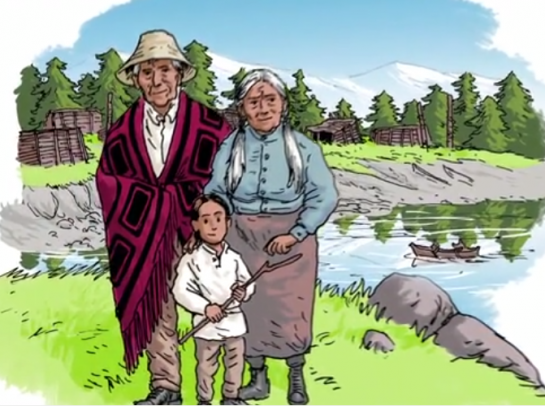
Na na7 kwetsi s7íxwalh, Etsím Skw’eshím̓ kwi snas. Nekw tsíyachisawánexw. Lhiḵ’ na wa ḵw’eshétsut. haw ḵ’as ya ḵ’esíwsnitas Ta selsí7ls ta sḵw’eshétsuts.
Na
wa ch’exwtím̓ ta si7ls ta x̱epiy̓éwelh.
Stl’i7s kwis húynexwas ti stsi7s.
Na melh tsuntem ta ímats nam̓ as ḵw’eshétas ta síiyay̓s, nilh kwis
ans ha7lh ta skwayl. Ta Etsím
Skw’eshím̓ iy ta síiyay̓s na nam̓ ḵw’eshétsut ch’it ta staḵw. An ḵex̱ ta ha7lh sḵw’eshétsutswit.
Small Number is a five year-old boy who gets into a lot of mischief. He lives with his Grandma and Grandpa, who patiently put up with his antics most of the time. Today, Grandpa needs to finish carving a feast dish and decides that Small Number should go out and play with his friends. It is a beautiful, sunny, spring day, and the boys run down to play near the water. Everything they see sparks a new game, and Small Number’s friend Big Circle suggests they see who can make a stone skip the farthest on the surface of the water. The boys quickly learn that for a stone to go far it needs to be smooth, flat, and oval shaped.
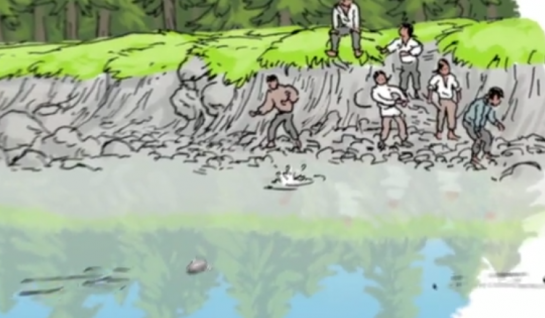
Na
na7 kwetsi siyáy̓s, Hiyí Shishi7ch kwi snas.
Na hey̓ḵwtas nam̓ aswit tsexwím̓ ta smant kwis xwíxwitims na7 ta
staḵw smen tél̓nexwaswit wa swa7s smant nam̓ as an x̱éta. Na melh yélx̱tas
i7x̱w ta s7íxwalh kwi smant, stl’i7s ta smants kwis ans ts’els, an tsewás,
tim̓á tkwi ḵelúm̓.
Everything they see sparks a new game, and Small Number’s friend Big Circle suggests they see who can make a stone skip the farthest on the surface of the water. The boys quickly learn that for a stone to go far it needs to be smooth, flat, and oval shaped.
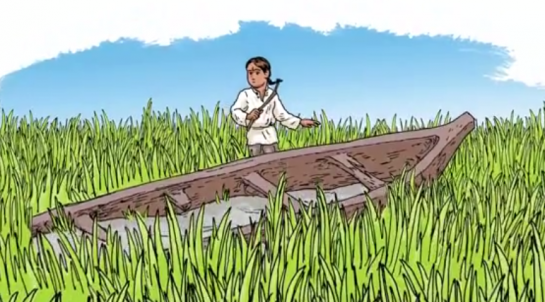
Ta Etsím Skw’eshím̓ na wa í7im̓esh ch’it ta staḵw ses men wa yélx̱tas ta yew̓án̓ ha7lh smant. Na x̱wiyaḵw’ántsut ta an tl’aḵt sáx̱wi7 ses men lhíkw’shen kwi stam as ses men txwnew̓ ta eskwekwín̓ snexwílh. Ta snexwílh ta kwáyantem na7 ta sáx̱wi7. Na melh lhx̱ilsh ta Etsím Skw’eshím̓ ses wa xwíkwin̓tas ta st’uḵw’chus. Ses men kw’acháy̓s ta snexwílh. Yamen kwis ans aaḵw, na7xw wa x̱wi7elwas. Iy kwis ans ha7lh ta na yélx̱nexwas, na melh ḵ’áytentas ta síiyay̓s. Na melh m̓i tskw’átsutwit.
Small Number wanders far along the shore looking for a winning stone. He scrambles through tall grass and trips over something, falling headfirst into an old canoe hidden in the grass. Small Number stands up, rubbing his forehead as he looks around at the canoe. Even though his head hurts, he is very excited at his discovery and he calls out to his friends, who come running.

Na wa lhilhx̱í7lsh wa shich’ántsutwit ta snexwílh, ses men tatsan̓taswit kwis
ans tsewás. tim̓á ḵ’as an eskwekwín̓
iy an hiyí. Na melh welḵw’áls ta
Etsím Skw’eshím̓, “Na7 way kw’in stélmexw wa em̓út wa iy̓áy̓ulh?”
Ses
men welḵw’áls ta Hiyí Shichi7ch, “Na7 way txwnch7am̓ kwi ses hin̓ kwi ses
chá7twilh?”
Na
melh máynexwas iytsi swi7ḵa7úl-lh ta sḵw’shétsut. Na melh xwi txwtéta7nitaswit ta snexwílh,
wa ḵwelḵwálwenwit swat as kwi na ta7s.
The boys stand around the canoe, running their hands along its smooth shape. It looks very old and very big to them. Small Number asks, “How many people do you think it could hold?” Big Circle asks, “How many generations ago was it built?” The boys forget their previous game and spend a long time talking about the canoe and who might have used it.
Yalh
ses m̓i t’eykw’ ta kw’el̓s ta Etsím Skw’eshím̓. “An chen kw’ákw’ay̓. Wi7ski nam̓ chet t’ukw’ kwis ilhen,” na
tsuntas ta síiyay̓s. Ses men tel̓númut
iytsi nach’ swi7ḵa7úl-lh kwis ans kw’ákw’ay̓ imen.
As they are talking, Big Circle’s tummy starts to growl. “I’m hungry. Let’s go eat,” he says to his friends. The other boys realize they are hungry too, and they all run back to the village.
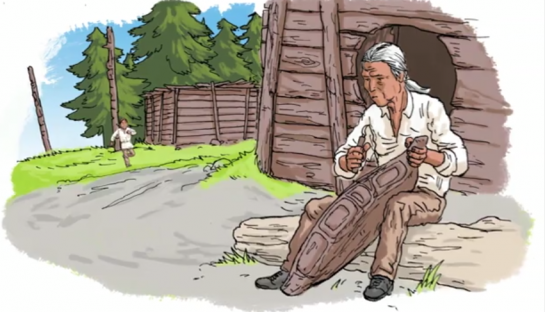
Na melh tskw’átsut t’ukw’ ta Etsím Skw’eshím̓. Ta si7ls, na wa ch’etxwántas ta lha7lhchs ta x̱epiyéwelh. Ses men ḵ’ayt ta Etsím Skw’eshím̓ ses men ta7úsem ta si7ls ses men kw’áchnexwas kwi ses x̱wuts’us, ses men welḵw’áls, “Chexw eshán̓?” Na máynexwas ta Etsím Skw’eshím kwi ses x̱wuts’us. Na tsuntas ta si7ls kwi ses mekw’em ta snexwílh na7 ta áyalhḵw, na tsut, “Chen mékw’em ta eskwekwín̓ snexwílh na7 ta áyalhḵw. Na7 lhkwun nách’aw̓ich syel̓ánem!”
Small Number races home, where Grandpa is carving the surface of a huge wooden dish. Small Number is shouting excitedly and Grandpa looks up. He sees the bruise on Small Number’s forehead. “What happened?!” Grandpa asks. Small Number has forgotten that he bumped his head and starts to tell Grandpa about finding the canoe: “I found an old canoe down on the beach! It must be at least a hundred years old!”
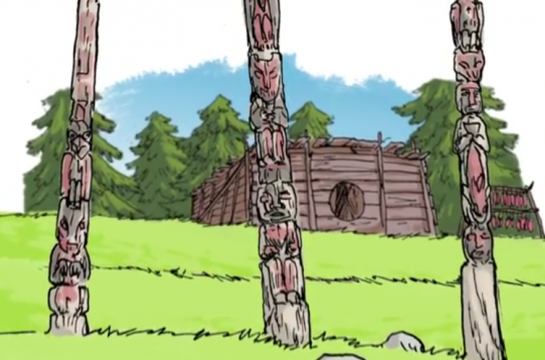
Na
nsx̱iyá7ms ta si7ls. “Chen tél̓nexw
kwetsi snexwílh. Na yexwt yew̓án̓
aw̓íts txwnam̓ ta i7x̱w ta snexwílh-chet.
Na tá7stem kwen man iy ta an̓us eḵw’í7tels.” Hiyí sḵwalwens ta si7ls, na men wá7ew, “An
nexwschá7twilh i7x̱w ta em7ímats kwen si7l.
Kw’éna ta chánat snexwílh na7 ta s7átsus ta tl’aḵtax̱an lam̓! I7x̱w ta na ta7stem kwi tiná7 tkwen sísi7.”
Grandpa smiles. “I know that canoe. It was once the fastest canoe in our village. It was built by my father and two of his brothers.” Grandpa proudly continues, “All the sons of my grandfather were known as great wood carvers. You know those three old totem poles in front of the longhouse? Each of them was built by one of my uncles. “
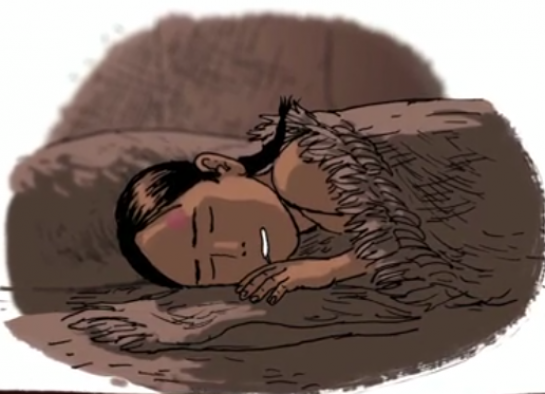
Iy
kwi ses wa nam̓ ítut, sḵwálwen ta Etsím Skw’eshím̓, “En-stl’i7 kwins
ch’etxwím̓ ta snexwílh iy ta sch’etxw tim̓á ten swa7ám̓. Kwayl as iy wilḵw’t chen kwen si7l kw’in as
ta kwúpits iy ta sḵa7ḵs. Wayti
án̓us, chánat, x̱a7útsen, wayti
ḵex̱.”
That evening, just before falling a sleep, Small Number thought, "I'd like to build canoes and totem poles just like my ancestors. I have to ask Grandpa tomorrow how many brothers his father had. Two, three, four, five or more..."
Swelḵw’áls:
Eshán̓ melh es ḵwelḵwálwen ta Etsím Skw’eshím̓ wayti án̓us s7eḵw’í7tels, wayti chanat ta s7eḵw’í7tels iy ḵ’as wayti ḵex̱ ta s7eḵw’í7tels kwa si7ls?
Question:
Why did Small Number think that his great-grandpa might have two, three, four, five or more brothers?
Credits and Acknowledgements
- Written by: Veselin Jungic, SFU and Mark MacLean, UBC
- Illustrator: Simon Roy, Victoria, B.C.
- Director: Andy Gavel, Simon Fraser University
Special thanks to:
- Tom Archibald, Simon Fraser University
- Peter Jacobs, Squamish Nation
- Ozren Jungic, University of Oxford
- Kwosel, Seabird Island First Nation
- Kwelaxtelot, Seabird Island First Nation
- Susan Russell, Simon Fraser University
- Erin Tait, Nisga'a Nation
- Department of Mathematics, Simon Fraser University
- Faculty of Science, Simon Fraser University
- The IRMACS Centre, Simon Fraser University
- Office for Aboriginal Peoples, Simon Fraser University
- Pacific Institute For Mathematical Sciences
This story is part of the NSERC PromoScience project "Math Catcher: Mathematics Through Aboriginal Storytelling"
Financial support provided by NSERC, PIMS, UBC, the IRMACS Centre, and SFU

